Is the backfist practical? Perhaps...
Is the backfist practical for self defense? A recent post by Argonautica prompted me to break it down for you. In The Chopper: The Pugilist’s Backfist, we learn that the backfist actually has a history in, believe it or not, boxing!
it may surprise some readers that the backfist, once called “the chopper,” was a common technique in western pugilism for a few hundred years. By pugilism, I’m referring specifically to bare knuckle boxing rather than the modern gloved boxing that took over at the end of the 19th century.
So what Argo is referring to is bare-knuckle, not boxing with gloves. This jibes with one of our TDA Tip posts, "It has almost no effect with boxing gloves on (other than the spinning variety), but without gloves is a great lead-off technique, and can stun an attacker with and set up many other techniques." The only modification that we make is to use the bottom of the hand (hammerfist) rather than the backfist. As detailed in Modify the Backfist for Practical Use, by modifying your attacking surface in this manner, you reduce or eliminate the chance or soft-tissue damage from using a knuckle on the wrong part of the head.
In a fascinating find, Argos details how one of the legendary fighters of boxing's pre-Queensbury era, Daniel Mendoza, used the "chopper" to great effect:
This blow was Mendoza’s favourite, and the power of striking it with dexterity often enables you to return with the same hand with which you parried the hit of your adversary. Thus, if you are struck at either side of the face, you may successfully raise up your elbow, catch the blow upon it, quickly bring round your arms, and give the chop. When the elbow is pointed a little upwards, it is the most favourable time for striking the chopper; because, by affording your arm a swing round, it gives a greater impulse to the blow.
So Mendoza liked it as a counter due to it's quickness and the difficulty in stopping it because the lead-off man was already extended and committed. It sounds like he uses what I call a lever move, where you use the upper arm to stop a hook, then drop a vertical (pictured below) or horizontal backfist. Great surprise move.
In my counter below, you'll notice I use the hammerfist instead, as mentioned above.
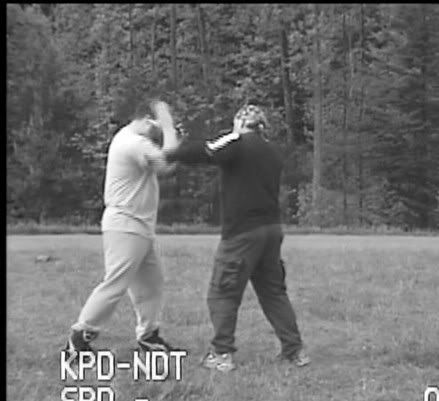 1 Block the left hook with the forearm/biceps
1 Block the left hook with the forearm/biceps
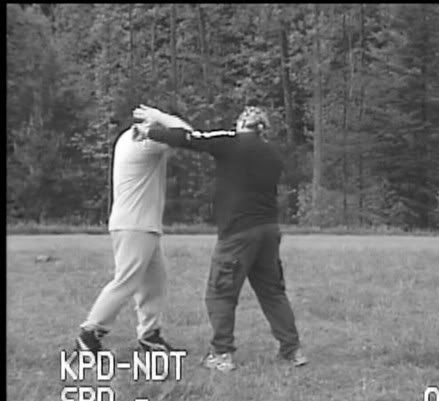 2 Shift the weight and torque the hips...
2 Shift the weight and torque the hips...
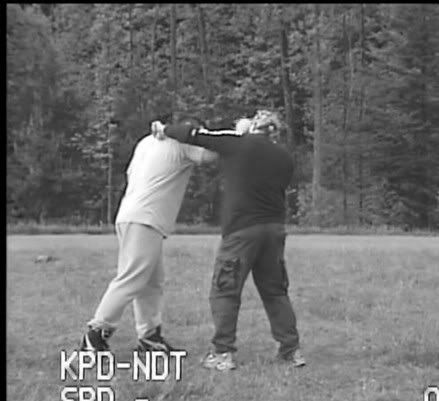 3 to drop the hammer (or backfist if you prefer)
3 to drop the hammer (or backfist if you prefer)
Argos sources expressed some skepticism, however:
Not all pugilism authorities were fond of the chopper. Lord Headley (R. G. Allanson-Winn), author of Boxing (1897), observed the transition from bare knuckles to gloves and not surprisingly found the chopper useless following the changeover. What was somewhat surprising was that Lord Headley thought it a weak blow even for bare knucklers:
A chopping hit from the elbow was made use of by some old timers, and though such a hit was capable of splitting a man’s nose, it was a poor hit and never could do much real damage, and in the present day it would be quite useless even for disfiguring purposes on account of the gloves.
I see the merit in both sides of the debate. It is a weak blow, in the sense that a knockout will not be scored from chopping the opponent. On the other hand, a strike breaking and splitting the nose or cutting the eyebrows or striking the eyes would be useful in an all-day bare knuckle match or a modern street encounter. A nice shot to the nose can be both disorienting and disheartening, resulting in the recipient watching through watery eyes as the claret flows down his chest. As the celebrated pugilist states, it also arrives in an unexpected manner because the line it takes is not “normal” in boxing.
In this, I completely agree. The standard backfist, unless struck under ideal conditions (timing, angle, and target), is a rather ineffectual blow on a fighter that is used to taking shots. I'd guess that's why you never see it in use in MMA or most street fights. However, with the modification to the hammerfist, it can be a quick counter, or even a good lead, and is great for stunning or setting up a combination.
Here, the fighter on the left uses a check of the front hand and a back hammerfist to great effect.
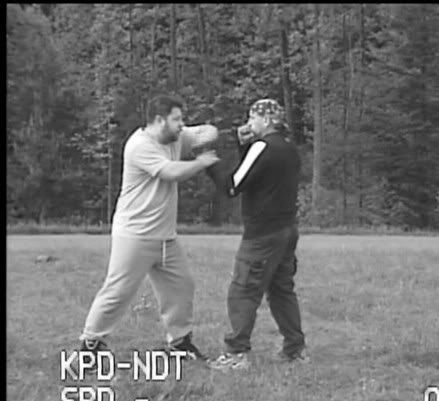 1 Check the front hand, chamber the side hammerfist for power, but keep the shoulder high for protection from the rear hand of the opponent.
1 Check the front hand, chamber the side hammerfist for power, but keep the shoulder high for protection from the rear hand of the opponent.
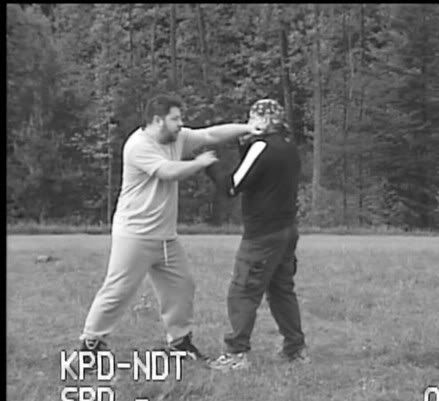 2 Deliver the side hammerfist
2 Deliver the side hammerfist
This is a demonstration of using the backfist in a flowing combination.
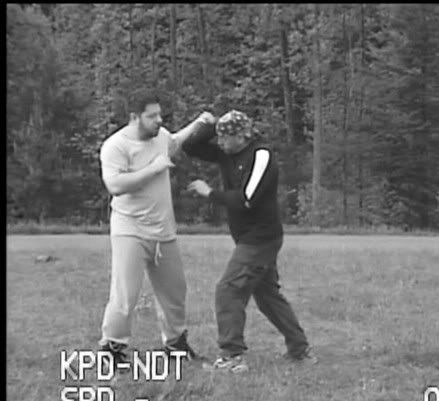 1 The lead hook is blocked by the fighter on the right.
1 The lead hook is blocked by the fighter on the right.
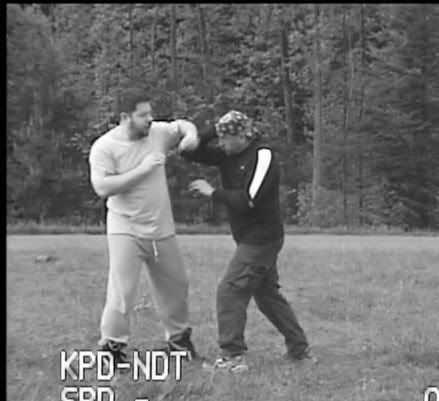 2 Instead of stopping and resetting (leaving an opening for a counter), follow through with the hook (again, keep the shoulder high).
2 Instead of stopping and resetting (leaving an opening for a counter), follow through with the hook (again, keep the shoulder high).
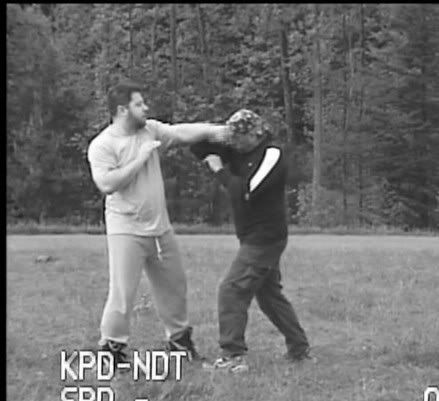 3 Deliver the back hammerfist (or backfist) to the temple or side of the neck.
3 Deliver the back hammerfist (or backfist) to the temple or side of the neck.
Conclusion:
Under the right circumstances (without gloves, and with modification to the striking surface), the backfist motion can be an effective opening, counter, or combination move. Give it a shot!
For more:
The Chopper: The Pugilist’s Backfist
Modify the Backfist for Practical Use
Creative combinations
Boxing for Self-Defense and MMA
What is an effective lead?
WEAPONS OF JEET KUNE DO: THE BACKFIST

2 comments:
I used to think that the backfist was a silly annoyance, best relegated to foxy boxing...then one of my instructors showed me a backhanded *slap* that was as powerful as a punch. I was incredulous!
Now I am a backfist believer. I don't use them often, but I do take them seriously.
Thanks for the comments, Chris.
I, too, felt the same way until I started sparring without boxing gloves, and did medium to heavy contact with MMA gloves. For me, it proved the effectiveness of two things: 1) how much you can hurt your hands going hard without boxing gloves (hence the hammers), and 2) how excellent open-hand techniques are for fitting into those places where gloved hands can't go. For example, the side of the neck, between the hands (uppercuts), etc.
I love power shots, but I love stunning shots to set up the KOs, too.
Post a Comment